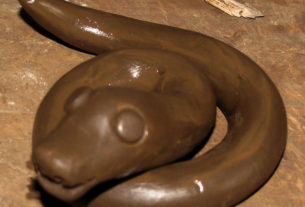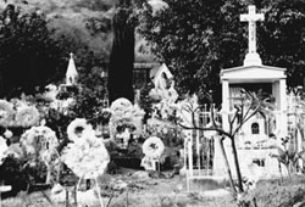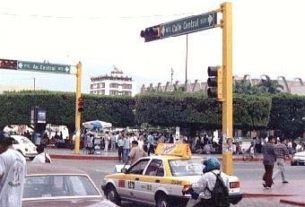José Guadalupe Posada is in the great tradition of cartoonists who double as political and social commentators. That tradition includes Honoré Daumier, whose merciless portraits of bourgeois society caused him to be acclaimed as the greatest social satirist of his day, Aubrey Beardsley, who illustrated Oscar Wilde’s Salomé, and such living political cartoonists as Herbert Block (Herblock), who took on McCarthyism and Stalinism with impartial fervor.
Posada was born in Aguascalientes on February 2, 1852. His early education was supervised by his brother, Cirilo, a country schoolteacher, who taught him drawing as well as reading and writing. As a young man he went to work in the taller (workshop) of Trinidad Pedroso, who taught him lithography and engraving. Before he was out of his teens Posada was doing political cartoons for the newspaper El Jicote.
In 1871 he suffered his first encounter with political repression. One of his targets had been the cacique (regional boss) Jesús Gómez Portugal, then out of office. But Gómez, who did not take kindly to being mocked, returned to power and Posada and Pedroso were forced to move to León, where they set up another print shop. Within a year they were heavily involved in a variety of activities: commercial and advertising work, illustration of books, and the printing of posters and representations of historical and religious figures. Among the latter were the Virgin of Guadalupe, the Virgin of the Rosary, the Holy Child of Atocha and Saint Sebastian.
In 1875 Posada married Maria de Jesús Vela; in 1883 he was hired as a teacher of lithography at the local Preparatory School. A disastrous flood struck León on June 18, 1888, and Posada was forced to relocate to Mexico City. There he went to work at a publishing company run by Ireneo Paz, famed liberal journalist and grandfather of Nobel Prize winner Octavio Paz. Posada, whose energy and dedication to work were legendary, began regularly to submit drawings and engravings to such well-known periodicals as La Patria Ilustrada, Revista de Mexico, El Padre Cobos, Los Almanaques de Padre Cobos, El Ahuizote and Nuevo Siglo. This activity kept Posada so busy that he had to open two additional workshops. Simultaneously, at the request of Paz, he was drawing political cartoons and astonishingly realistic sketches of daily life in the old San Pedro and San Pablo quarter, near the Merced Market.
Unlike other social satirists, there was nothing of the elitist about Posada. In 1880 Antonio Vanegas Arroyo and his son Blas came to the capital from Puebla and established a press aimed at producing inexpensive literature for the masses: historical profiles, comedies, farces, hair-raising thrillers, songs and histories of saints. These sold mainly in plazas and market places. Venegas and his son also founded a number of popular newspapers, among them El Centavo Perdido, La Gaceta Callejera and El Boletín. To the press and to these newspapers, Posada was a prolific contributor.
In his heyday, Posada functioned as unofficial captain of a team that included Antonio and Blas Venegas, Manuel Manilla, a talented engraver who greatly influenced Posada, and Constancio Suárez, poet and editor from Oaxaca who expressed the group’s ideas in articles and editorials. These ideas were based on the principle of bringing a popular, anti-establishment message to the mass of citizens who lived so miserably under the Porfirio Díaz dictatorship.
Manilla, who died in 1893, and Posada were the artists who best interpreted the life and social attitudes of the Mexican people. Taking Mexico’s traditional Day of the Dead (November 2) celebration as his theme, Posada would stage shows with skeletons in working class barrios, in suburban communities and even in the houses of the rich. During these productions the skeletons would ride bicycles or be garbed in the latest finery. His use of skeletons as a metaphor for a corrupt society ranks Posada as a pioneer expressionist. Posada supplemented macabre humor with lampoons against venal and tyrannical politicians. For these transgressions, he was thrown into jail on several occasions. During this period in Mexico City, one of Posada’s greatest admirers was a youth who had come to the capital from Jalisco. His name was José Clemente Orozco.
Because this gifted and hardworking man was perennially out of official favor, he died on January 20, 1913, as poor as he had been born. He was buried in a sixth class grave (the lowest category) in the Dolores Cemetery. Since nobody claimed the remains, they were thrown out seven years after his death.
The recognition that eluded Posada during his lifetime would come after his death. There are collections of his works at the Bellas Artes National Institute, the Biblioteca de Mexico (“Library of Mexico”), the National Library of Anthropology and History and the Municipal Archive of the city of León. Among U.S. authors who have paid tribute to Posada is the late Frances Toor, well-known authority on Mexican folkways. There is a chapter on him in Mexican Folkways (1928) and a book, Posada, Printmaker to the Mexican People, published in 1944.



